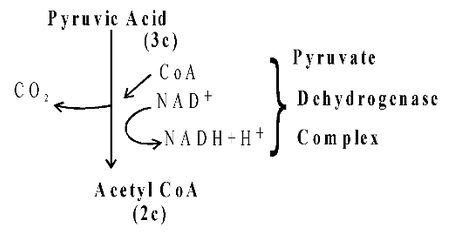Aerobic Respiration
Cellular Respiration of Class 11
About Aerobic Respiration
Common Pathway
It consists of three steps : Glycolysis (common for aerobic and anaerobic respiration), Kreb’s cycle and Oxidative phosphorylation.
Glycolysis (EMP - Pathway)
It was discovered by Embden - Meyerhof - Paranas (EMP)
Glycolysis (G.k. ‘Glycos’ = Sugar + ‘Lysis’ = Splitting)
It is an enzymatic, 10 stepped reductive process in which glucose/fructose/sucrose/respiratory substrate is reduced to form pyruvic acid with the production of ATP and reducing power (NADH2).
It starts with glucose (6C compound) and ends in pyruric acid (CH3COCOOH), a 3C compound.
Glycolysis yields only 5% of total ATP in respiration.
Anaerobic glycolysis was the first process to occur during the origin of life.
Nearly all the glycolytic enzymes require Mg++ as cofactor for their activity.
Intermediates of glycolysis are either 6–C or 3–C compounds.
There is no decarboxylation (production of CO2) in glycolysis.
Glyceraldehyde 3–phosphate (GAP) and dihydroxyacetone 3–phosphate (DHAP) these are triose sugars which do not occur in nature. These are tautomers and exist in dynamic equilibrium. DHAP is isomerised into PGAL. Thus total 2 molecules of PGAL are formed. This PGAL acts as connecting link between respiration and photosynthesis.
In Glycolysis synthesis of ATP is direct through substrate level phosphorylation at step 7 and 10.
4 ATP molecules (2 at step 7 and 2 at step 10) are produced and 2 are consumed (one at step 1 and other step 3) and therefore, net gain is 2 ATP.
2 molecules of NADH + 2H+ (reducing power) at step 6 when PGAL (GAP) is oxidised into 1, 3-bisphosphoglyceric acid.
4 molecules of H2O are formed (2 each at step 6 and 9) and two are consumed at step 5. Thus net gain of H2O is 2 molecules.
If oxygen is available, these 2 molecules of NADH + 2H+ enter into mitochondria and oxidise through ETS to form 6 ATP. Thus aerobic glycolysis can produce 2 + 6 = 8 ATP. Anaerobic glycolysis produces only 2 ATP.
Transition Reaction
If oxygen is not available, pyruvic acid undergoes anaerobic respiration / fermentation to form lactic acid/alcohol. But under aerobic conditions pyruvic acid formed in glycolysis enters in the matrix of mitochondria. It is not used directly in the Kreb’s cycle. It first undergoes acetylation by oxidative decarboxylation using pyruvate dehydrogenase complex to form a 2 carbon energy rich compound called acetyl~CoA (CH3.CO~SH.CoA) also called activated acetic acid or active acetate as follows :

Pyruvate Dehydrogenase complex consists of enzymes dehydrogenase, decarboxylase and transacetylase and also associated with the enzyme complex are Mg2+, TPP (thiamine pyrophosphate) and lipoic acid.
This step of Acetyl~CoA formation is also called Gateway step or link reaction. It acts as connecting link between glycolysis, Krebs’ cycle and oxidation of fat. It is an irreversible reaction occurs in matrix of mitochondria and produces 2 molecules each of NADH+H+, CO2 and Acetyl~CoA. These 2 molecules of NADH+H+ on oxidation in ETS produce 2 H2O and 6 ATP.









